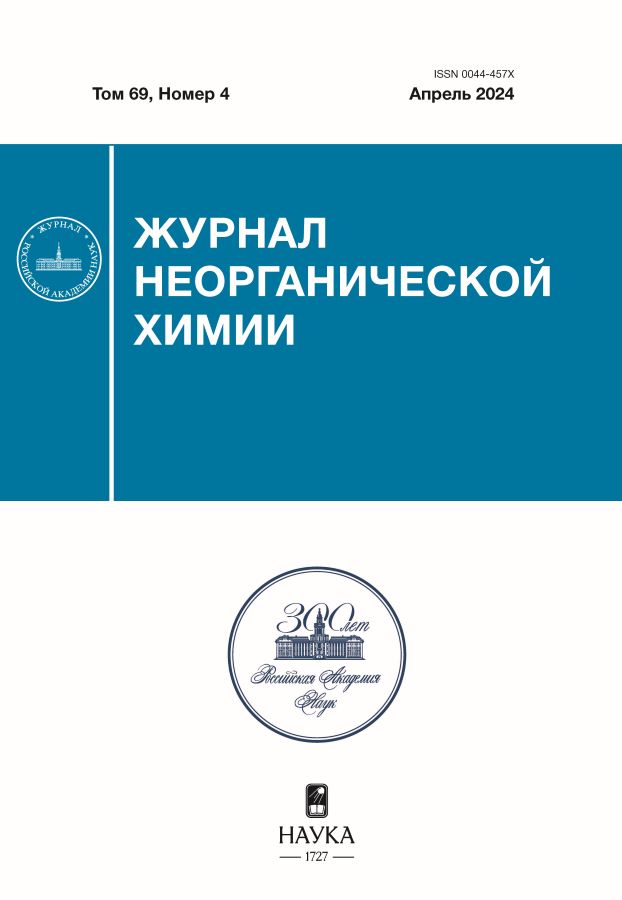Spectral properties of tolan and its supramolecular complexes in solution and silicate hydrogel
- Autores: Novitskii G.O.1, Medvedeva A.A.1, Koshkin A.V.1, Vedernikov A.I.1, Lobova N.A.1,2
-
Afiliações:
- Photochemistry Center of the Russian Academy of Sciences, Federal Research Center “Crystallography and Photonics” – National Research Center “Kurchatov Institute”
- Moscow Institute of Physics and Technology
- Edição: Volume 69, Nº 4 (2024)
- Páginas: 528-536
- Seção: ФИЗИКОХИМИЯ РАСТВОРОВ
- URL: https://hum-ecol.ru/0044-457X/article/view/666567
- DOI: https://doi.org/10.31857/S0044457X24040087
- EDN: https://elibrary.ru/ZYHXKG
- ID: 666567
Citar
Texto integral
Resumo
The complexation process of tolane and α-cyclodextrin in water, aqueous-ethanol solution and silicate hydrogel based on tetrakis(2 hydroxyethyl)orthosilicate was studied. The complex formation in solutions were confirmed by electron and 1H NMR spectroscopy, and the stability constant of the complex was determined using spectrofluorimetric titration (lgK1:1 = 1.5). The preservation of the inclusion complex during the preparation of the gel was confirmed by electron spectroscopy.
Texto integral
Sobre autores
G. Novitskii
Photochemistry Center of the Russian Academy of Sciences, Federal Research Center “Crystallography and Photonics” – National Research Center “Kurchatov Institute”
Autor responsável pela correspondência
Email: georg.nov97@gmail.com
Rússia, Moscow, 119421
A. Medvedeva
Photochemistry Center of the Russian Academy of Sciences, Federal Research Center “Crystallography and Photonics” – National Research Center “Kurchatov Institute”
Email: georg.nov97@gmail.com
Rússia, Moscow, 119421
A. Koshkin
Photochemistry Center of the Russian Academy of Sciences, Federal Research Center “Crystallography and Photonics” – National Research Center “Kurchatov Institute”
Email: georg.nov97@gmail.com
Rússia, Moscow, 119421
A. Vedernikov
Photochemistry Center of the Russian Academy of Sciences, Federal Research Center “Crystallography and Photonics” – National Research Center “Kurchatov Institute”
Email: georg.nov97@gmail.com
Rússia, Moscow, 119421
N. Lobova
Photochemistry Center of the Russian Academy of Sciences, Federal Research Center “Crystallography and Photonics” – National Research Center “Kurchatov Institute”; Moscow Institute of Physics and Technology
Email: georg.nov97@gmail.com
Rússia, Moscow, 119421; Dolgoprudny, 141701
Bibliografia
- Wilson A. J. // Annu. Rep. Prog. Chem., Sect.B: Org. 2007. V. 103. P. 174. https://doi.org/10.1039/b614407c
- Pistolis G., Balomenou I. // J. Phys. Chem. B 2006. V. 110. № 33. P. 16428. https://doi.org/10.1021/jp062003p
- Tian T., Wang Y., Zhang W. et al. // ACS Photonics 2020. V. 7. № 8. P. 2132. https://doi.org/10.1021/acsphotonics.0c00602
- Connors K.A. // Chem. Rev. 1997. V. 97. № 5. P. 1325. https://doi.org/10.1021/cr960371r
- Dodziuk H. // Molecules with Holes – Cyclodextrins, 2006. https://doi.org/10.1002/3527608982.ch1
- Walter G., Coche A. // Nucl. Instruments Methods 1963. V. 23. № C. P. 147. https://doi.org/10.1016/0029-554X(63)90027-2
- Aurisicchio C., Ventura B., Bonifazi D. et al. // J. Phys. Chem. C 2009. V. 113. № 41. P. 17927. https://doi.org/10.1021/jp9053988
- Menning S., Kra M., Coombs B.A. et al. // J Am Chem Soc 2013. V. 135. P. 2160. https://doi.org/10.1021/ja400416r
- Saifi A., Joseph J.P., Singh A.P. et al. // ACS Omega 2021. V. 6. № 7. P. 4776. https://doi.org/10.1021/acsomega.0c05684
- Asiri A.M., El-Daly S.A., Khan S.A. // Spectrochim. Acta – Part A Mol. Biomol. Spectrosc. 2012. V. 95. P. 679. https://doi.org/10.1016/j.saa.2012.04.077
- Al-Sherbini E.S.A.M. // Microporous Mesoporous Mater. 2005. V. 85. № 1–2. P. 25. https://doi.org/10.1016/j.micromeso.2005.06.016
- Dolinina E.S., Parfenyuk E.V. // Russ. J. Inorg. Chem. 2022. V. 67. № 3. P. 401. https://doi.org/10.1134/S0036023622030068
- Buslaeva T.M., Ehrlich, G.V., Volchkova E.V. et al. // Russ. J. Inorg. Chem. 2022. V. 67. P. 1191. https://doi.org/10.1134/S0036023622080058
- Ooya T., Kobayashi N., Ichi T. et al. // Sci. Technol. Adv. Mater. 2003. V. 4. № 1. P. 39. https://doi.org/10.1016/S1468-6996(03)00003-2
- Koshkin A.V., Aleksandrova N.A., Ivanov D.A. // J. Sol-Gel Sci. Technol. 2017. V. 81. № 1. P. 303. https://doi.org/10.1007/s10971-016-4183-0
- Brandhuber D., Torma V., Raab C. et al. // Chem. Mater. 2005. V. 17. № 3. P. 4262. https://doi.org/10.1021/cm048483j
- Castellano S., Lorenc J. // J. Phys. Chem. 1965. V. 69. № 10. P. 3552. https://doi.org/10.1021/j100894a051
- Armitage J.B., Entwistle N., Jones E.R.H.W.M.C. // J. Chem. Soc. 1954. V. 147. № 111. P. 147. https://doi.org/10.1039/JR9540000147
- Du H., Fuh R.C.A., Li J. et al. // Photochem. Photobiol. 1998. V. 68. № 2. P. 141. https://doi.org/10.1111/j.1751-1097.1998.tb02480.x
- Gans P., Sabatini A., Vacca A. // Talanta 1996. V. 43. № 10. P. 1739. https://doi.org/10.1016/0039-9140(96)01958-3
- Li Z., Sun S., Liu F. et al. // Dye. Pigment. 2012. V. 93. № 1–3. P. 1401. https://doi.org/10.1016/j.dyepig.2011.10.005
- Shchipunov Y.A., Karpenko T.Y., Bakunina I.Y. et al. // J. Biochem. Biophys. Methods 2004. V. 58. № 1. P. 25. https://doi.org/10.1016/S0165-022X(03)00108-8
- Koshkin A.V., Medvedeva A.A., Lobova N.A. // High Energy Chem. 2019. V. 53. № 6. P. 444. https://doi.org/10.1134/S0018143919060110
Arquivos suplementares




















